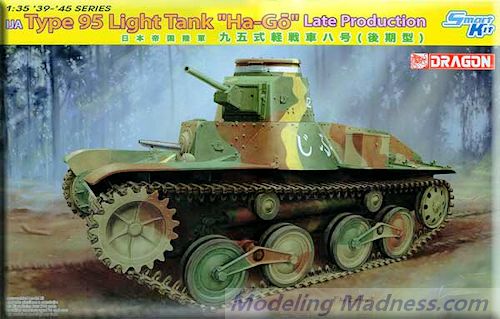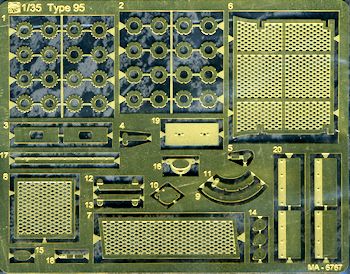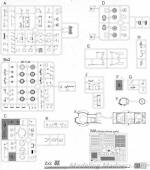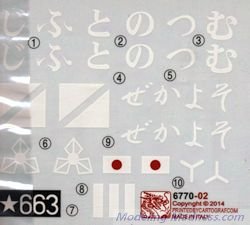
| KIT #: | 6770 |
| PRICE: | $59.00 SRP |
| MARKINGS: | Four options |
| REVIEWER: | Scott Van Aken |
| NOTES: |

| HISTORY |
From early 1930s, the Japanese army began experimenting on amechanized warfare unit combining infantry with tanks. However, theType 89 Medium tank could not keep pace with the motorized infantry, which could move at 40 km/h by truck.To solve this problem, the Army Technical Bureau proposed a new light tank of 7 tonnes or less capable of 40 km/h speed and started development in 1933. The prototype of the new tank was begun in 1933 and completed in 1934 at the Army's Sagami Arsenal. Initial tests were positive but it was too heavy at 7.5 tonnes and had to be reworked bringing the weight down to 6.5 t. Due to doubts by the infantry as to its capability for infantry support it was tested in Manchuria in the winter of 1934/1935. The reports were favourable and a second prototype built, being completed in November 1935. In 1935, at a meeting in the Army Technical Bureau, the Type 95 was proposed as the main tank formechanized infantry units. The infantry had concerns that the armor was insufficient; however, thecavalry indicated that the improved speed and armament compensated for thin armor. In the end, the infantry agreed, as the Type 95 was still superior to the only available alternative, which was thearmored car.
Production was started in 1936 byMitsubishi Heavy Industries. By 1939, 100 units had been built. Mitsubishi would go on to build a total of 853 in their own factories, with another 1,250 units built by the Sagami Arsenal,Hitachi Industries, Niigata Tekkoshō, Kobe Seikoshō, andKokura Arsenal.
The Type 95 was a 7.4-tonne vehicle with a complement of 3 crewmen: a commander, a hull machine gunner, and a driver. Only the commander was seated in the turret, hence he was responsible for observation, loading, aiming, firing the main gun, as well as decision-making and commanding the crew. The hand-operated turret was small and extremely cramped.
The primary armament of the most produced version was aType 98 37 mm gun with the barrel length of 46.1 calibers. It elevated between −15 to +20 degrees. The tank carried two types of 37 mm ammunition, the high-explosive and armor-piercing. For the latter,muzzle velocity was 675–700 m/s, and the armor penetration was 25 mm at a distance of 500 m.
Secondary armament consisted of two 7.7 mmType 97 light machine guns, one mounted in the hull and the other in the turret, not coaxially with the main gun but facing to the rear right (that is, in the five-o-clock direction).
The most characteristic feature of the Type 95 tank was its simplesuspension system. Twobogie wheels were suspended on a singlebell crank with two bell cranks per side. The tracks were driven through the front sprockets. There were two return wheels. The suspension had troubles early on, with a tendency to pitch so badly on rough ground that the crew sometimes found it impossible to drive at any speed, and so it was modified with a brace to connect the pairs of bogies. Despite this, the tank continued to give its users a rough ride across any uneven ground. It was provided with an interior layer of asbestos, primarily to isolate the crew from the sun-heated armor plates, but also to protect from injury when the tank moved at high speed across rough terrain.
Type 95 was fitted with 120 hp (89.5 kW) Mitsubishi NVD 6120 air-cooleddiesel engine.
Some tanks were fitted with tworeflectors in the front of the vehicle fornight operations.
| THE KIT |

 The kit comes with a nice photo etch fret that includes engine intake screens and a screen for the muffler. There are also small plates that go on the inside and outside of the road wheels and a few other various bits and pieces. Some of these are replacements for kit bits and require the kit part to be removed in order to use them. I also found it interesting that there are options for some of the more mundane things. For instance, there is a hatch with the handle molded in place or one can use the part that has a separate handle. Things like that. Guess it is a need to increase the parts count or something.
The kit comes with a nice photo etch fret that includes engine intake screens and a screen for the muffler. There are also small plates that go on the inside and outside of the road wheels and a few other various bits and pieces. Some of these are replacements for kit bits and require the kit part to be removed in order to use them. I also found it interesting that there are options for some of the more mundane things. For instance, there is a hatch with the handle molded in place or one can use the part that has a separate handle. Things like that. Guess it is a need to increase the parts count or something.
The various guns are all complete, inside and out, which is nice for those who want to build up an interior of some sort. The kit uses Dragon's excellent DS tracks. These are easy to assemble and hold paint just like any other styrene part. One just has to be careful with the cement.
You would expect new bits to differentiate between this kit and the two previous boxings. While the list is not long, it includes a new cupola on the turret, and rounded front fenders (the Early-Production type’s fenders were flat and squarely cut off). The frontal armor and glacis plate are suitably modified too, plus the towing hook on the front is new

 Instructions are well drawn with the usual Gunze and Model Master paint references. Four tanks are offered, each with the same basic colors. The first one is from the 14th Tank Regiment on Peleliu in 1944 as is the second option. The third is Company C of the 14th Tank Regiment in Malaya in 1944 and also from 1944 is the last option from Company 1 of the 9th Tank Regiment on Guam. The decal sheet (which I have darkened) is nicely printed and offers what few markings are on these vehicles.
Instructions are well drawn with the usual Gunze and Model Master paint references. Four tanks are offered, each with the same basic colors. The first one is from the 14th Tank Regiment on Peleliu in 1944 as is the second option. The third is Company C of the 14th Tank Regiment in Malaya in 1944 and also from 1944 is the last option from Company 1 of the 9th Tank Regiment on Guam. The decal sheet (which I have darkened) is nicely printed and offers what few markings are on these vehicles.
| CONCLUSIONS |
For those of you wanting Japanese armor, but couldn't justify the cost of those from other makers, this may well be your opportunity.With only 210 parts, it is a kit that will not keep you up nights building and will make into a very nice model for your shelves.
| REFERENCES |
http://en.wikipedia.org/wiki/Type95_light_tank
June 2014
Thanks to www.dragonmodelsusa.com for the preview kit. You can find this kit at your favorite hobby shop or on-line retailer.
If you would like your product reviewed fairly and fairly quickly, please contactthe editor or see other details in the